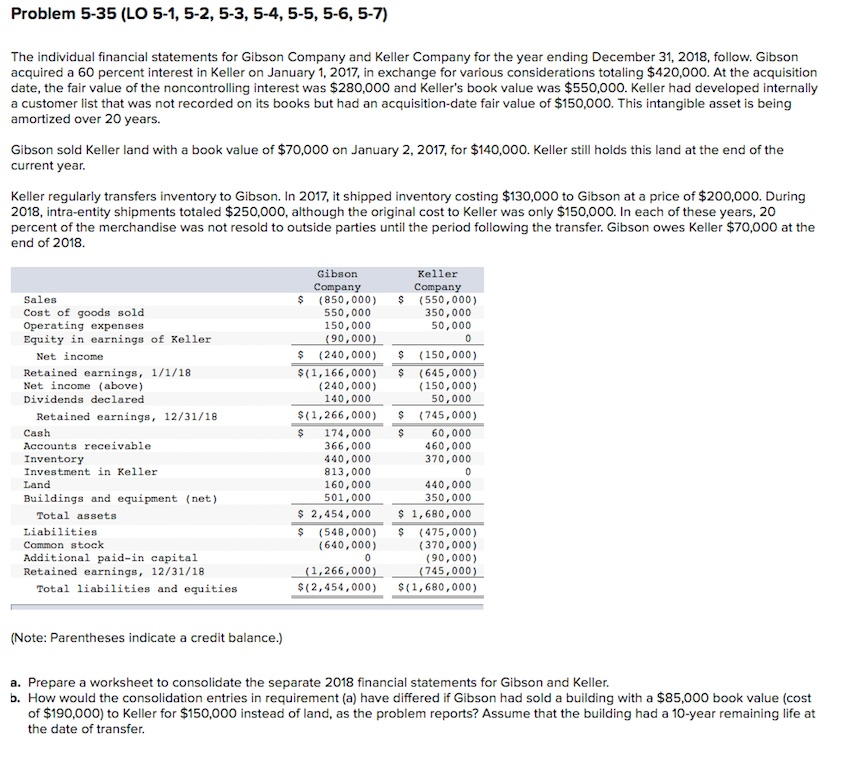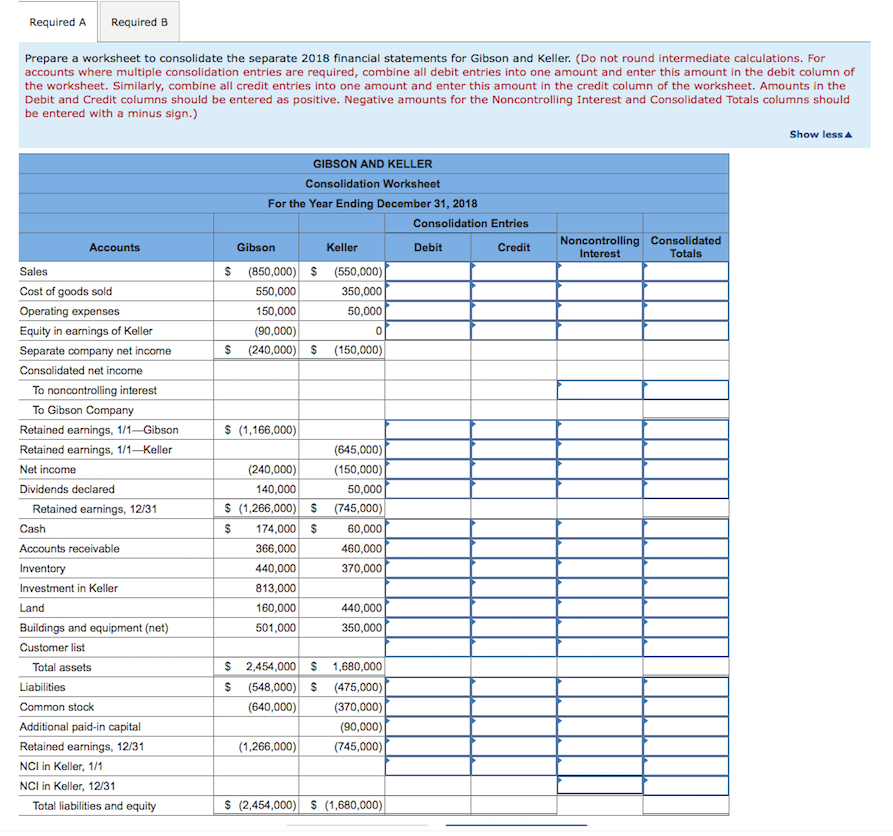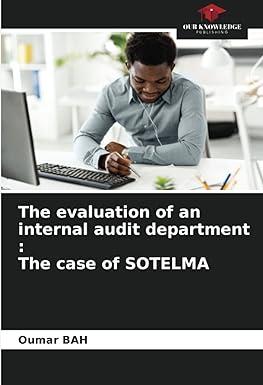


Problem 5-35 (LO 5-1, 5-2, 5-3, 5-4, 5-5, 5-6, 5-7) The individual financial statements for Gibson Company and Keller Company for the year ending December 31, 2018, follow. Gibson acquired a 60 percent interest in Keller on January 1, 2017, in exchange for various considerations totaling $420,000. At the acquisition date, the fair value of the noncontrolling interest was $280,000 and Keller's book value was $550,000. Keller had developed internally a customer list that was not recorded on its books but had an acquisition-date fair value of $150,000. This intangible asset is being amortized over 20 years Gibson sold Keller land with a book value of $70,000 on January 2, 2017, for $140,000. Keller still holds this land at the end of the current year. Keller regularly transfers inventory to Gibson. In 2017, it shipped inventory costing $130,000 to Gibson at a price of $200,000. During 2018, intra-entity shipments totaled $250,000, although the original cost to Keller was only $150,000. In each of these years, 20 percent of the merchandise was not resold to outside parties until the period following the transfer. Gibson owes Keller $70,000 at the S end of 2018. Keller Gibson Company (550,000) 350,000 50,000 0 Company (850,000) 550,000 150,000 Sales S Cost of goods sold Operating expenses Equity in earnings of Keller (90,000) Net income (240,000) S (150,000) Retained earnings, 1/1/18 Net income (above) $(1,166,000) (240,000) S (645,000) (150,000) 50,000 Dividends declared 140,000 (745,000) $(1,266,000) Retained earnings, 12/31/18 Cash 174,000 366,000 440,000 813,000 160,000 501,000 S 60,000 460,000 370,000 Accounts receivable Inventory Investment in Keller Land 0 440,000 350,000 Buildings and equipment (net) $ 1,680,000 2,454,000 Total assets Liabilities (548,000) (640,000) S (475,000) Common stock (370,000) (90,000) (745,000) Additional paid-in capital Retained earnings, 12/31/18 0 (1,266,000) $(2,454,000) $(1,680,000) Total liabilities and equities (Note: Parentheses indicate a credit balance.) Prepare a worksheet to consolidate the separate 2018 financial statements for Gibson and Keller. b. How would the consolidation entries in requirement (a) have differed if Gibson had sold a building with a $85,000 book value (cost of $190,000) to Keller for $150,000 instead of land, as the problem reports? Assume that the building had a 10-year remaining life at the date of transfer a. Required B Required A Prepare a worksheet to consolidate the separate 2018 financial statements for Gibson and Keller. (Do not round intermediate calculations. For accounts where multiple consolidation entries are required, combine all debit entries into one amount and enter this amount in the debit column of the worksheet. Similarly, combine all credit entries into one amount and enter this amount in the credit column of the worksheet. Amounts in the Debit and Credit columns should be entered as positive. Negative amounts for the Noncontrolling Interest and Consolidated Totals columns should be entered with a minus sign.) Show less GIBSON AND KELLER Consolidation Works heet For the Year Ending December 31, 2018 Consolidation Entries Noncontrolling Consolidated Interest Gibson Accounts Keller Debit Credit Totals (850,000) (550,000) 550,000 Sales Cost of goods sold 350,000 Operating expenses 150,000 50,000 Equity in earnings of Keller (90,000) 0 (240,000) S (150,000) Separate company net income Consalidated net income To noncontrolling interest To Gibson Company (1,166,000) Retained earnings, 1/1-Gibson (645,000) Retained earnings, 1/1-Keller (240,000) Net income (150,000) Dividends declared 140,000 50,000 $ (1,266,000) S (745,000) Retained earnings, 12/31 S S Cash 174,000 60,000 460,000 Accounts receivable 366,000 440,000 Inventory 370,000 Investment in Keller 813,000 160,000 440,000 Land Buildings and equipment (net) 501,000 350,000 Customer list 1,680,000 2,454,000 Total assets S (548,000) S Liabilities (475,000) (640,000) (370,000) Common stock Additional paid-in capital (90,000) (1,266,000) Retained earnings, 12/31 (745,000) NCI in Keller, 1/1 NCI in Keller, 12/31 (2,454,000) (1,680,000) Total liabilities and equity Required B Required A How would the consolidation entries in requirement (a) have differed if Gibson had sold a building with a $85,000 book value (cost of $190,000) to Keller for $150,000 instead of land, as the problem reports? Assume that the building had a 10-year remaining life at the date of transfer. (Do not round intermediate calculations. If no entry is required for a transaction/event, select "No journal entry required" in the first account field.) view transaction list Consolidation Worksheet Entries 1 2 Prepare Entry TA to defer the intra-entity gain as of the beginning of the year Note: Enter debits before credits. Transaction Accounts Debit Credit Record entry Clear entry view consolidation entries









